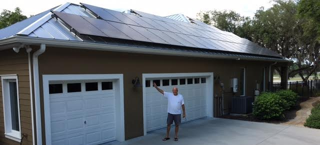Why Florida’s monopoly utilities are trying to stop customer-owned solar
 Florida utilities spent more than $20 million in trying to pass Amendment 1. This was a wolf-in-sheep’s clothing ballot initiative that purported to support solar growth, but actually would have made it harder for us to go solar. The utilities’ were ultimately unsuccessful, as voters saw through their gambit. But, this failed effort raises a question: why are utilities so determined to stop us from going solar?
Florida utilities spent more than $20 million in trying to pass Amendment 1. This was a wolf-in-sheep’s clothing ballot initiative that purported to support solar growth, but actually would have made it harder for us to go solar. The utilities’ were ultimately unsuccessful, as voters saw through their gambit. But, this failed effort raises a question: why are utilities so determined to stop us from going solar?
Nationally, solar photovoltaic (PV) installation costs have fallen by more than 70% in the past decade. The total capacity of installed solar has tripled since 2010. Solar now accounts for the majority of new electricity generation capacity additions. Hundreds of thousands of Americans have propelled this solar momentum, installing solar arrays on their own homes and businesses.
This grassroots solar momentum combined with dramatic system cost declines has Florida’s electric utilities worried.
Why is rooftop solar a threat to monopoly utilities?
Electric utilities typically generate income two ways. They sell electricity to customers or they build electric grid infrastructure, such as power plants and transmission lines. Solar panels are a distributed power source. This means they create electricity at or near the source of use. This is counter to traditional electricity generation which occurs at large, centralized locations and is then transmitted long distances to the point of end use.
The emergence of solar PV as a cost effective and easy to maintain ‘generator’ has enabled us to become our own energy suppliers. So, as we install more solar, we purchase less electricity from the utilities and reduce the need for costly investment in new power plants and transmission lines. While solar means increased energy freedom, resilience and local job creation for Floridians, utilities see it as lost revenue.
Increased solar adoption is good for all utility customers, as we are the ones who pay for rising energy costs and investments in new grid infrastructure. This introduces competition and cuts into utility profit margins. Florida’s largest utilities are investor owned utilities. This means they are managed as private, for profit entities. While they are governed as ‘regulated monopolies’ by the Florida Public Service Commission, their primary purpose is to generate revenue for shareholders.
Customer-owned, ‘rooftop’ solar reduces revenue to utility shareholders by reducing demand for their products (electricity and power infrastructure). This is particularly concerning to utilities since they have seen overall growth in electric demand remain flat and even decline since 2009. This flat demand is due to energy efficiency and decreased industrial activity. Solar is poised to lower electricity demand from utilities further. So, utilities are trying to hold on to their profit margins by blocking solar’s growth. Because of this, we can expect to see more attempts, like Amendment 1, by utilities to make it harder for us to go solar.
